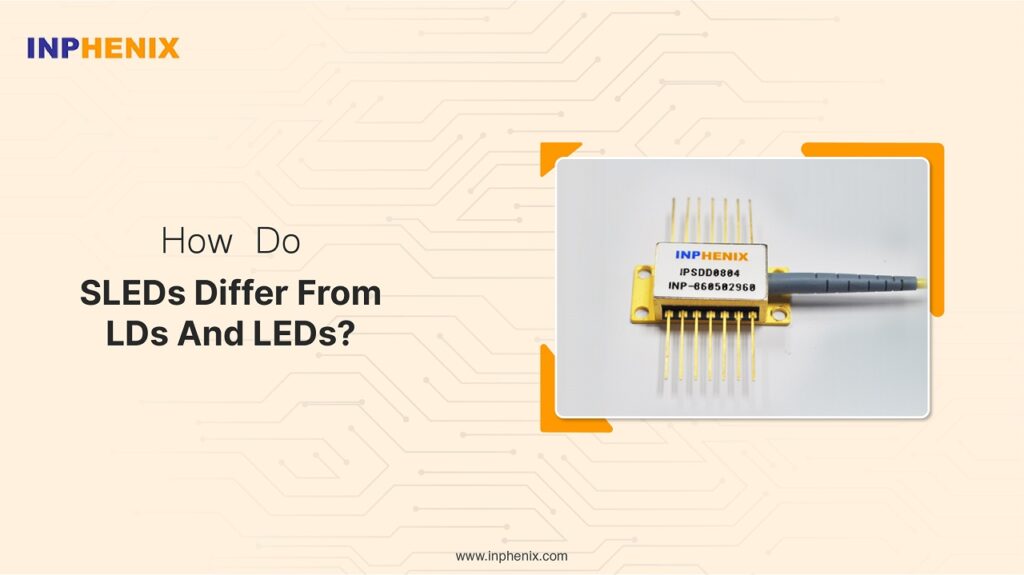
The SLED’s peak wavelength and intensity are influenced by the active material’s composition as well as the degree of injection current. SLEDs, unlike laser diodes, are made to have strong single pass amplification for spontaneous emission produced along the waveguide but inadequate feedback to produce lasing activity.
One sort of technology that can fill the void between light-emitting diodes (LEDs) and laser diodes is superluminescent diodes. The concentrated beam of the light source and effective usage of light is promoted by a technique of producing light based on enhanced spontaneous emission.
In this blog, we’ll explore how SLEDs differ from LDs and LEDs.

A superluminescent diode is a semiconductor that produces light in the superluminescent edge state. Superluminescent diodes, unlike laser diodes, are not equipped with sufficient feedback to carry out the lasing act, while being engineered to have strong single pass amplification for spontaneous emission created along the waveguide.
Early in the 1970s, SLDs were created in the selenide material system with the intention of creating an emitter with poor time coherence of the produced light that could be connected to an optical fiber. At the time, the SLD wavelength was produced with an anti-reflective coating, and the semiconductor emitters were made as a double-heterostructure type.
Let’s move on to the differences and similarities between LED, LED, and SLED.
Broadband semiconductor devices known as superluminescent light-emitting diodes (SLEDs) are closely linked to their more well-known alternatives, laser diodes and light-emitting diodes (LEDs). All three designs use electrical current injection to emit light and are made up of positively (p)-doped and negatively (n)-doped portions.
Superluminescent emitting diodes are a type of semiconductor that uses electrically charged injections to produce broad-spectrum light. They generate bandpass light with a sharp laser beam, and LEDs, which emit broadband light rays. In this way, SLEDs may be thought of as broadband semiconductor lasers with a beam-like output.
Broadband describes the visible signal that SLEDs generate as being wide in the wavelengths or variable frequency. Through the Fourier series, the unique features are connected to the frequency response.
In the feature space, a source of light that is broad in the frequency response is narrowband or has a short coherence length. SLEDs are essentially incoherent laser diodes in this context.
However, only within its coherence length may light from one light source interact with light from another or the same source. Once the discrepancies in route between both the conflicting light waves are less than the light’s cut-off wavelength, they reflect off surfaces that are never exactly flat and even cause so-called speckles.
It is thought of as noise when there are random dark and white interference patterns. The long continuation for a long time of narrowband laser diodes causes low speckle noise to be a common phenomenon. SLEDs are therefore comparable to semiconductor lasers without speckles.
Since of their productivity coherence and improvements, SLEDs are the preferable light source in various applications because it considerably reduces speckle or interference noise in imaging applications. Because of its coherence length of a few microns, which equates to the axial resolution of the imaging instruments, broadband SLEDs are employed in various fields, such as multi-beam photography.
| Features | LED | SLED | LD |
|---|---|---|---|
| Principal of Light Generation | Spontaneous Emission | Amplified Spontaneous Emission | Stimulated Emission |
| Optical Spectrum | Broadband | Broadband | Narrowlated or Multiple Fabry-Perot Modes |
| Total Optical Output Power | Medium | Medium | High |
| Optical Power Density | Low | Medium | High |
| Light Emittance | No | Yes | Yes |
| Optical Waveguide | All Directions | Divergence-Limited | Diverence-Limited |
| Spatial Coherence | Low | High | High |
| Coupling into Single-Mode Fibers | Poor | Efficient | Efficient |
| Temporal Coherence | Low | Low | High |
| Generation of Speckle Noise | Low | Low | High |
| Polarization State | Random | Linear | Linear |
These are the differences and similarities between LD, LED, and SLED. Due to SLED’s special qualities, they are necessary for several applications where a mix of excellent beam quality and low coherence is required. We expect that reading this blog has improved your comprehension of LD, LED, and SLED.
Inphenix is a company based in the United States that designs and manufactures lasers and light sources that are widely used in a variety of industries. Please contact us for more information.
